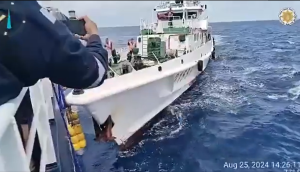Chinese and Philippine vessels have once again collided close to a disputed shoal in the South China Sea, the latest sign of continuing maritime tensions between the two sides.
As has now become routine, the two governments each issued statements detailing yesterday’s incident and assigning blame in the opposite direction. In a statement, a Philippine government task force accused the China Coast Guard (CCG) of ramming and firing water cannons at the BRP Datu Sanday, a vessel of the Bureau of Fisheries and Aquatic Resources (BFAR), which was transporting diesel, food and medical supplies to Filipino fishermen at Sabina Shoal.
While en route from Half Moon Shoal to Sabina Shoal, the Datu Sanday “encountered aggressive and dangerous maneuvers from eight People’s Republic of China maritime vessels,” the task force said. The CCG vessels “made close perilous maneuvers that resulted in ramming, blasted horns, and deployed water cannons against the BFAR vessel.”
These “unprofessional, aggressive and illegal actions posed serious risks to the safety of the Filipino crew and the fishermen they were meant to serve,” the statement added. In line with its transparency strategy, the task force also released videos of the incident, which appeared to show the use of water cannons and the two collisions.
China, which claims most of the Spratly Islands under its expansive “nine-dash line” maritime claim, accused the Philippine vessel of responsibility for the incident. According to the Associated Press, CCG spokesperson Gan Yu said that the Philippine ship sailed toward the Chinese coast guard ship “unprofessionally” and “dangerously,” causing the two vessels to come into contact with each other.
“The responsibility is totally on the Philippines’ side. We sternly warn that the Philippine side must immediately stop the infringement and provocation, otherwise it must bear all consequences,” Gan said.
The Philippines also felt the need to refute a claim, made in some Chinese state media reports, that the CCG rescued crew from the Datu Sanday who had fallen overboard. In a statement, the National Security Council said that the reports were “completely unfounded” and that the misinformation “serves as a clear illustration of the PRC’s willingness to distort the truth and engage in disinformation to bolster its public image.”
Yesterday’s clash was the second that has taken place at Sabina Shoal since China and the Philippines reached a provisional “understanding” to manage tensions at Second Thomas Shoal last month. These tensions, which involved CCG efforts to interdict Philippine supply missions to the garrison stationed aboard a grounded warship on the shoal, culminated in a violent clash on June 17, in which a Filipino sailor lost a finger in a melee with Chinese personnel.
Following the incident, Manila and Beijing promised to “restore trust” and “rebuild confidence” in order to prevent their maritime disputes from spiraling into open conflict. That was followed by a provisional arrangement allowing the PCG and Philippine Navy to resupply the Second Thomas Shoal garrison. Since then, the Philippines has carried out one resupply mission without incident.
Last week, however, the two sides confirmed that a collision occurred between CCG vessels and two ships from the Philippine Coast Guard (PCG), in waters close to Sabina Shoal, which lies around 60 kilometers to the east of Second Thomas Shoal – and only around 140 kilometers northwest of the Philippine island of Palawan. (Both features sit well within the Philippines’ internationally recognized Exclusive Economic Zone.) The Philippines claimed that both vessels were damaged in the August 19 encounter.
Yesterday’s incident, which came a day after the Philippines claimed that one of its BFAR aircraft was threatened by flares fired from Chinese-occupied Subi Reef while on a routine patrol, suggests that after reaching a point of diminishing returns at Second Thomas Shoal, China has simply redirected its pressure campaign to other parts of the Spratly Islands. In doing so, it has seemingly identified Sabina Shoal as a point of vulnerability of the Philippines – and a place over which it might be forced to relinquish control.































